With the beginning of the hot season, mosquitoes begin to teem in our countrysides.
The most terrible are these small buzzing mosquitoes the bite of which are very irritating (when they are not more expanding of diseases).
Luckily for some of us, at the moment, in temperate countries, they are only pricking.
The big mosquitoes, here represented, are doubtless the least harmful for the man, with their big body soft and their a little bit bumpy flight.
What we said in 1690 in the dictionary of Furetiere :
MOSQUITO, is a small flying insect which falls with big pain and importunity. The mosquitoes and the flies have six big legs, have no neck, and have a trunk which they stretch out and remove, by means of which they suck the blood of animals, and the other liqueurs on which they feed. In America we are so much saddened with mosquitoes, that we could not sleep in the air, nor have no bare part of the body. To defend itself from it, it is necessary to put some paper under its stockings, because their prickle can it leak out. To make them go out of a room(, it is necessary to put a light outside, they run up there, and then we quickly close all the windows. Menage diverts this word of culicinus, formed by culex.
Ce qu'en disait en 1833 le dictionnaire d'Histoire Naturelle de Guérin:
MOSQUITO, Culex. Genre of Dipterans of the family of Némocères, established by Linné and having for characters: threadlike antennas, of fourteen articles; a long, advanced trunk, containing a sucker of five silks; the palps in males is longer than the trunk, and very-short in females.
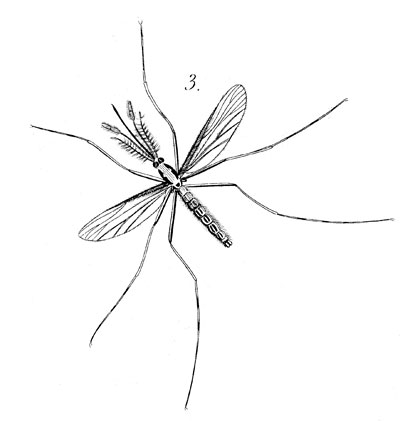
A mosquito, an engraving extracted from the Atlas of the dictionary of Guérin
These insects have the very-small, rounded off head, the spherical eyes; antennas, inserted near them, are very-hairy in males; the hairs which decorate them take out of with every articulation, and often form panaches; the rostrum, which contains the trunk, is lengthened, the males 's palps are very lengthened, and participate in their extremities of the power which have the antennas to be very-hairy, so that we sometimes confused them together; the corselet is very high, as hunchbacked; wings, fringed in their edge and on their nervures, are big, exceeding the body, on which they are lying in the rest; legs are very-long, the rear limbs especially; the only tarsi are almost also long as thighbones and shins taken together; the belly is lengthened, twice cylindrical, so long as the corselet. Mosquitoes are small very-uncomfortable insects, in what they pursue us with doggedness to feed on our blood; the low, wet and fresh places, as the edge of meadows and dark wood, are the places where we find them most, often; it is that to the day fall that they appear in the other places, because they are afraid of the big heat; but they spread in apartments, if we have no care of holding them closed, and take advantage of your sleep to attack you; The small whining which they make listen is not less uncomfortable, because it holds you in a continual concern. Their sting is very-painful; what returns her(it) such is less the introduction of the loose instrument which produces it, that the effect of a poisonous liqueur which the insect introduces into the wound, in the effect to make more liquid the portion of our blood which has to get through its delicate organs; but it is in the Southern countries where Mosquitoes are really formidable, and we are obliged, to protect itself from their infringements, to surround the beds of veils in gauze, called mosquito nets. Colonies are infested with the other species which the authors named Mosquitoes and Gnats, and which are, in to say all the travelers, a real plague for the people and the animals; however these species do not belong all to the genre Mosquito itself. The agonies which Mosquitoes make endure in the hot countries would persuade that the North, already little favored, in other consideration, should be shielded from this plague; but that's not the case, and the Lapp unfortunates are reduced to rub themselves hands and face of fat, and to live constantly in the middle of the smoke, to be able to escape in their attacks. However painful is the sting of these small animals, the process by which it takes place deserves to be known;when the Mosquito settled on the place where he believes he can make penetrate into his trunk, it tilts the head, by holding its high (posterior legs, it supports at first the end of its sucker (see fig. 4), and then makes penetrate into silks, which he(it) contains; but as the sucker does not penetrate, the quantity silks of which could penetrate would be very small, if the nature had not provided there; the sucker complies towards its environment with more or less sharp angle (fig. 4-5), as one > put aside can represent it, among which both branches get closer more or less, as silks penetrate more or less before, until come to contact. When the insect withdraws, the girdle makes a support which favors this movement : quand le Moustique s’est posé à la place où il croit pouvoir faire pénétrer sa trompe, il incline sa tête, en tenant ses pattes postérieures élevées, il appuie d’abord le bout de son suçoir (voyez fig. 4), et fait ensuite pénétrer les soies, qu’il renferme ; mais comme le suçoir ne pénètre pas, la quantité dont les soies pourraient pénétrer serait bien minime, si la nature n’y avait pourvu; le suçoir se plie vers son milieu à angle plus ou moins aigu (fig. 4-5), comme peut le représenter un > mis de côté, dont les deux branches se rapprochent plus ou moins, selon que les soies pénètrent plus ou moins avant, jusqu’à venir se toucher. Quand l’insecte se retire, la gaine fait un point d’appui qui favorise ce mouvement : we believe to be sure that it is the only females which attack us with so much doggedness.
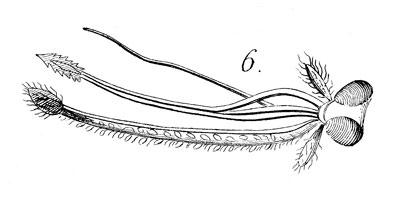
Head of mosquito and oral device
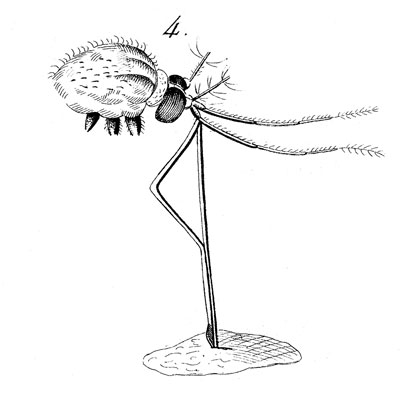
Sucker of mosquito getting ready to bite
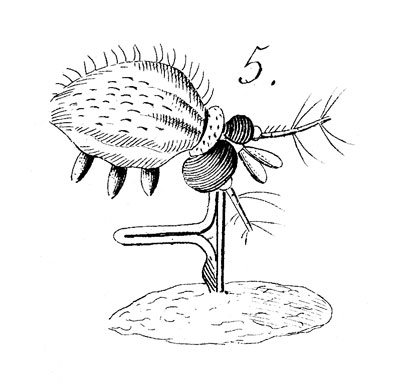
Mosquito sucking the blood
Mosquitoes do not still find people, or animals the blood of which they can suck, and it is more than likely that ninety-nine on enjoy hundred it even never; they attack then plants, in the shade of the leaves of which they are held during the day heat, they rock there constantly, by folding with enough speed and by raising alternately the articulations of their legs; to the brunette they go out of their retreat, either to look their food, or to couple; it is in the air that the coupling takes place; males are held by groups there, and rock there constantly from top to bottom; a female contacts this group, and a male dashing after her, contacts it and the coupling takes place, and often they fly some time placed end to end; but a little time after. Female parts from the male and prepares to make its eggs: it is on the water that she has to put down her eggs, and they have to float, and the insect has to distrust itself an element which would be fatal to him(her); he(it) thus looks on the surface of the water for a small sheet(leaf), for a wisp of straw on which he(it) fastens with the previous four legs; it crosses then its two big posterior legs with the extremity of its belly, and lets pour an egg, then two, etc., etc., meanwhile triangular that they form ; as the number of eggs increases, the interval also increases, then it narrows little by little, so that when the eggs, which rises from two hundred fifty to three hundred eggs, are ended, the mass looks like well enough a small boat a little raised in both ends; the insect then lets it flow on the water, and gives up it in the impulses of the wind; because it is always on still waters, as quieter, that these eggs are put down. These eggs have a very-singular shape, they represent well enough jars in stoneware where we contain the named liqueur to kirchwasser, except that, tidied up side by side, the neck is in the bottom, and forms the only part( which communicates with the water; because these eggs are afraid as much of the flood as of the drought; the part forming the neck is closed by a very-thin membrane, which breaks the larva which is and so on in the middle of the element where she has to live.
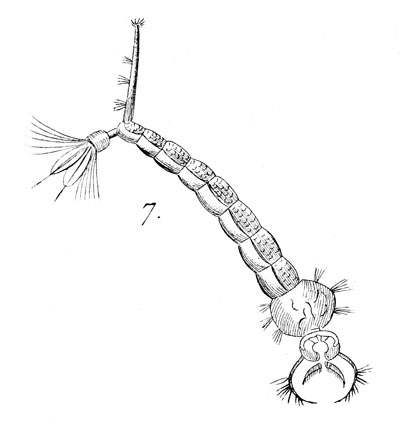
Strongly enlarged larva of mosquito
The larva is apode (fig. 7); the head is rounded off, méplate, we distinguish two blackheads there at which we consider as eyes; it is before equipped with small barbs among which bigger two articulated and which she(it) holds in a continual excitement, so forming whirlwinds which, maybe, attract towards its mouth of the microscopic animals, the fragments of vegetables or the earthy portions of which it makes its food; the corselet is round, provided on each side with two bouquets of hairs; the belly, long, more narrow than the corselet in its junction with him, and still narrowing in its extremity, consists of nine segments having each on the side a bouquet of hairs; this belly is ended in a singular way; it bends at first abruptly in right angle down to truncate downright; in that extremity is the opening of the anus, closed by four membranes lengthened in the shape of leaves ; the front last ring offers to its top an appendix about of the same thickness as the anal ending, much more lengthened, getting loose obliquely from the body, ended with a star in five points; it is by this star that the insect inhales the air which it needs to live, also it holds it constantly on the surface of water, whereas there is an opposite head there; as soon as some object worries it or as soon as the water is shaken, he(it) gives some knocks of tail and rushes at the bottom; but soon, by its specific gravity much lesser than the water, it goes back up to to take back its usual place. It undergoes several metamorphoses, and passes finally in the state of nymph; here his(her,its) shape becomes at least so singular (fig. 8); it offers well the appearance of a chrysalis, that is we distinguish antennas, wings and legs; but the breath, which took place by the extremity of the body, takes place now by the back by means of two small cornets implanted by the point, and the opening of which it holds a hour flower of water as the larva held(liked) it the extremity of its body, in the exception that it folds up along the breast its belly the extremity of which is armed(equipped) with two round leaves ; it also rushes at the bottom when he dreads some danger, by raising his body and by striking the water with his tail.
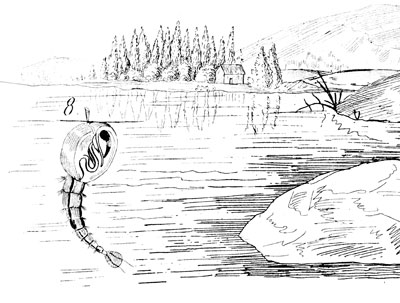
Nymph of mosquito in its pond
When comes the moment of the last metamorphosis, the nymph extends horizontally on the surface of water, the skin of the corselet splits, and the insect begins to go out; the back gets free at first a little, it contracts its belly, succeeds in getting free a few of its sheath, and, by being made a support, it widens the opening and brings out its corselet; the head at the same time gets free, and the insect eventually finds in balance on the extremity of its belly, on the boat hardly so big as him, because it is the skin which it is soon going to leave (fig. 9). This moment is the most critical of all the metamorphoses by which the insect had to pass; a wave, a breath of air can knock down it ; but, before the one or the other one arrives, he was able to pull his previous four legs, and immediately he puts them on the water by pushing aside them; by means of this support, it succeeds in releasing its wings and its long posterior legs, and a few moments later he(it) takes its flight. These insects give several generations a year, and if birds, fishes and other carnivorous aquatic insects, without counting the various accidents which can arrive at them under all the states, killed a big quantity, they would soon become a plague.
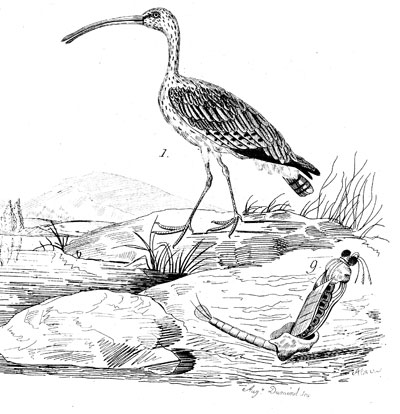
Bird Curlew (1) in edge of pond and mosquito going out of his(her) nymph (9)
Photography of the week 18 of 2013
|
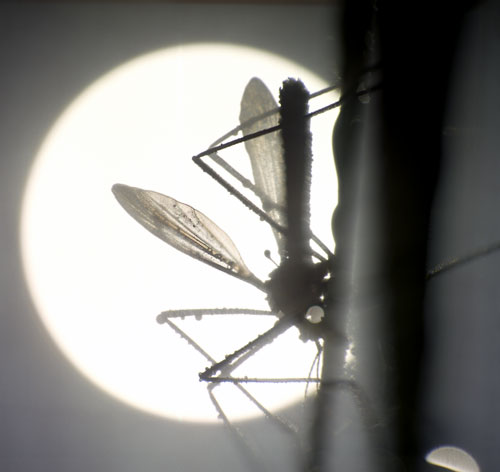
![]()